
The United Nations Convention on the Law of the Sea (UNCLOS), also called the Law of the Sea Convention or the Law of the Sea Treaty, is an international agreement that establishes a legal framework for all marine and maritime activities. As of June 2016, 167 countries and the European Union are parties.

A continental shelf is a portion of a continent that is submerged under an area of relatively shallow water known as a shelf sea. Much of these shelves were exposed by drops in sea level during glacial periods. The shelf surrounding an island is known as an insular shelf.
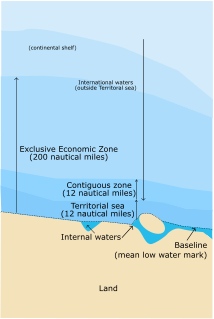
The term territorial waters is sometimes used informally to refer to any area of water over which a state has jurisdiction, including internal waters, the territorial sea, the contiguous zone, the exclusive economic zone and potentially the continental shelf. In a narrower sense, the term is used as a synonym for the territorial sea.

Law of the sea is a body of international law governing the rights and duties of states in maritime environments. It concerns matters such as navigational rights, sea mineral claims, and coastal waters jurisdiction.

An exclusive economic zone (EEZ), as prescribed by the 1982 United Nations Convention on the Law of the Sea, is an area of the sea in which a sovereign state has special rights regarding the exploration and use of marine resources, including energy production from water and wind. It stretches from the baseline out to 200 nautical miles (nmi) from the coast of the state in question. It is also referred to as a maritime continental margin and, in colloquial usage, may include the continental shelf. The term does not include either the territorial sea or the continental shelf beyond the 200 nautical mile limit. The difference between the territorial sea and the exclusive economic zone is that the first confers full sovereignty over the waters, whereas the second is merely a "sovereign right" which refers to the coastal state's rights below the surface of the sea. The surface waters, as can be seen in the map, are international waters.
International law also known as "law of nations" is the name of a body of rules which regulate the conduct of sovereign states in their relations with one another. Sources of international law include treaties, international customs, general widely recognized principles of law, the decisions of national and lower courts, and scholarly writings. They are the materials and processes out of which the rules and principles regulating the international community are developed. They have been influenced by a range of political and legal theories.

The International Tribunal for the Law of the Sea (ITLOS) is an intergovernmental organization created by the mandate of the Third United Nations Conference on the Law of the Sea. It was established by the United Nations Convention on the Law of the Sea, signed at Montego Bay, Jamaica, on 10 December 1982. The Convention entered into force on 16 November 1994, and established an international framework for law over all ocean space, its uses and resources. The ITLOS is one of four dispute resolution mechanisms listed in Article 287 of the UNCLOS.
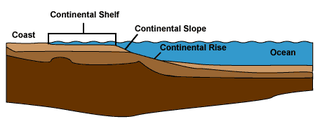
A continental margin is the outer edge of continental crust abutting oceanic crust under coastal waters. It is one of the three major zones of the ocean floor, the other two being deep-ocean basins and mid-ocean ridges. The continental shelf is the relatively shallow water area found in proximity to continents. The continental margin consists of three different features: the continental rise, the continental slope, and the continental shelf. Continental margins constitute about 28% of the oceanic area.[1]

According to the United Nations Convention on the Law of the Sea, a nation's internal waters include waters on the side of the baseline of a nation's territorial waters that is facing toward the land, except in archipelagic states. It includes waterways such as rivers and canals, and sometimes the water within small bays.
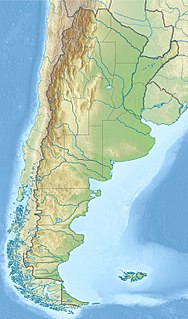
The Argentine Sea is the name given to the sea within the continental shelf off the Argentine mainland. It lacks international recognition but is symbolically important to Argentina for consolidating the country's national unity behind the concept of Argentine irridentism, an area that extends out to include the British South Atlantic islands and a section of the Antarctic continent.
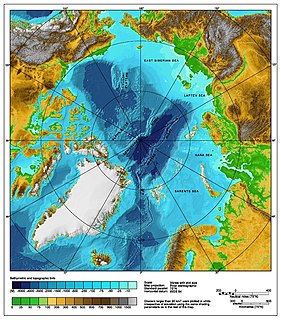
The Arctic consists of land, internal waters, territorial seas, exclusive economic zones (EEZs) and international waters above the Arctic Circle. All land, internal waters, territorial seas and EEZs in the Arctic are under the jurisdiction of one of the eight Arctic coastal states: Canada, Denmark, Finland, Iceland, Norway, Russia, Sweden and the United States. International law regulates this area as with other portions of Earth.

Portugal has the 5th largest exclusive economic zone (EEZ) within Europe, 3rd largest of the EU and the 20th largest EEZ in the world, at 1,727,408 km2.
The continental shelf of Russia is a continental shelf adjacent to the Russian Federation. Geologically, the extent of the shelf is defined as the entirety of the continental shelves adjacent to Russia's coast. In international law, however, the United Nations Convention on the Law of the Sea more narrowly defines the extent of the shelf as the seabed and subsoil of the submarine areas over which a state exercises sovereign rights.
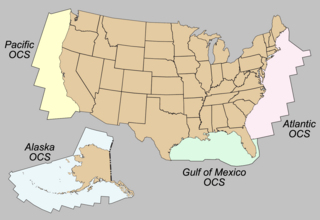
The Outer Continental Shelf (OCS) is a feature of the geography of the United States. The OCS is the part of the internationally recognized continental shelf of the United States which does not fall under the jurisdictions of the individual U.S. states.

The Convention on the Continental Shelf was an international treaty created to codify the rules of international law relating to continental shelves. The treaty, after entering into force 10 June 1964, established the rights of a sovereign state over the continental shelf surrounding it, if there be any. The treaty was one of three agreed upon at the first United Nations Convention on the Law of the Sea. It has since been superseded by a new agreement reached in 1982 at UNCLOS III.
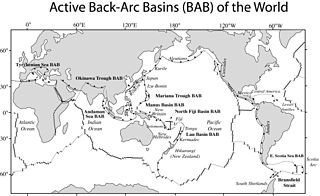
The Okinawa Trough is a seabed feature of the East China Sea. It is an active, initial back-arc rifting basin which has formed behind the Ryukyu arc-trench system in the West Pacific. It developed where the Philippine Sea Plate is subducting under the Eurasia Plate.
The equidistance principle, or principle of equidistance, is a legal concept in maritime boundary claims that a nation's maritime boundaries should conform to a median line that is equidistant from the shores of neighboring nations. The concept was developed in the process of settling disputes in which the borders of adjacent nations were located on a contiguous continental shelf:
An equidistance line is one for which every point on the line is equidistant from the nearest points on the baselines being used. The equidistance principle is a methodology that has been endorsed by the United Nations Convention on the Law of the Sea but predates that treaty and has been used by the Supreme Court of the United States, states, and nations to establish boundaries equitably.
An archipelagic state is a designation used for island countries that consist of an archipelago. The designation is legally defined by the United Nations Convention on the Law of the Sea (UNCLOS). In various conferences, The Bahamas, Fiji, Indonesia, Papua New Guinea, and the Philippines are the five original sovereign states that obtained approval in the UNCLOS signed in Montego Bay, Jamaica on 10 December 1982 and qualified as the archipelagic states.

The Chukchi Plateau or Chukchi Cap is a large subsea formation extending north from the Alaskan margin into the Arctic Ocean. The ridge is normally covered by ice year-round, and reaches an approximate bathymetric prominence of 3,400 m with its highest point at 246 m below sea level. As a subsea ridge extending from the continental shelf of the United States north of Alaska, the Chukchi Plateau is an important feature in maritime law of the Arctic Ocean and has been the subject of significant geographic research. The ridge has been extensively mapped by the USCGC Healy, and by the Canadian icebreaker CCGS Louis S. St-Laurent in 2011 and RV Marcus Langseth, a National Science Foundation vessel operated by the Lamont-Doherty Earth Observatory of Columbia University.

Several states have claimed interests over the sea bed adjoining Rockall, an uninhabitable granite islet which is located within the exclusive economic zone (EEZ) of the United Kingdom. Ireland, Denmark, Iceland, and the United Kingdom have all made submissions to the commission set up under the United Nations Convention on the Law of the Sea (UNCLOS).













